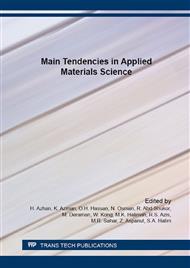p.493
p.497
p.505
p.510
p.517
p.523
p.528
p.534
p.539
Electrical Impedance Spectroscopy and Fourier Transform Infrared Studies of New Binary Li2CO3-LiI Solid Electrolyte
Abstract:
Low ionic conductivity and easily attacked by air are among the common issues of lithium salts in lithium based solid electrolytes. Toward this end, our efforts have been focused on the development of a new lithium based electrolyte system which exhibits a good stability against atmosphere and posses high electrical conductivity. Normally, lithium carbonate (Li2CO3) alone shows a low electrical conductivity (2×10-5 Scm-1). However, the corporation of lithium iodide (LiI) has made a significant impact on the electrical conductivity of the system (4.63×10-3 Scm-1). The xLi2CO3-yLiI (x = 95-70, y = 5-30 wt.%) solid electrolyte were prepared by mechanical milling technique. The electrical and structural properties of the electrolyte systems were characterized by Electrical Impedance Spectroscopy (EIS) and Fourier Transform Infrared (FTIR) respectively. The highest electrical conductivity (4.6×10-3 Scm-1) of the electrolyte system was obtained from the sample containing 20 wt.% of lithium iodide (LiI). The carbonate groups play a role to provide sites for the interaction between interconnected pathways and lithium ions for the fast lithium ion migration.
Info:
Periodical:
Pages:
517-522
Citation:
Online since:
March 2016
Authors:
Price:
Сopyright:
© 2016 Trans Tech Publications Ltd. All Rights Reserved
Share:
Citation:


